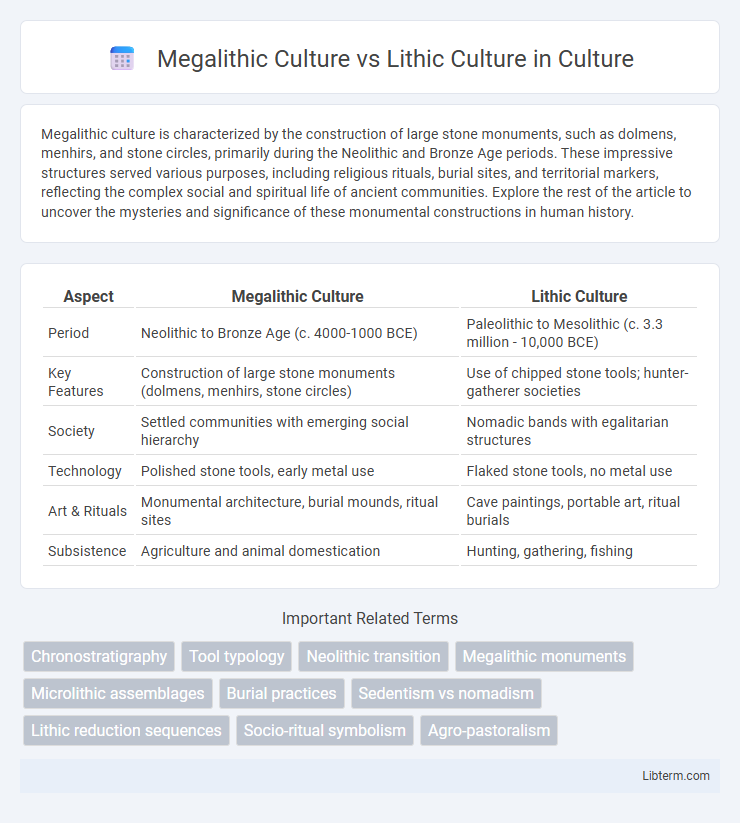Megalithic culture is characterized by the construction of large stone monuments, such as dolmens, menhirs, and stone circles, primarily during the Neolithic and Bronze Age periods. These impressive structures served various purposes, including religious rituals, burial sites, and territorial markers, reflecting the complex social and spiritual life of ancient communities. Explore the rest of the article to uncover the mysteries and significance of these monumental constructions in human history.
Table of Comparison
| Aspect | Megalithic Culture | Lithic Culture |
|---|---|---|
| Period | Neolithic to Bronze Age (c. 4000-1000 BCE) | Paleolithic to Mesolithic (c. 3.3 million - 10,000 BCE) |
| Key Features | Construction of large stone monuments (dolmens, menhirs, stone circles) | Use of chipped stone tools; hunter-gatherer societies |
| Society | Settled communities with emerging social hierarchy | Nomadic bands with egalitarian structures |
| Technology | Polished stone tools, early metal use | Flaked stone tools, no metal use |
| Art & Rituals | Monumental architecture, burial mounds, ritual sites | Cave paintings, portable art, ritual burials |
| Subsistence | Agriculture and animal domestication | Hunting, gathering, fishing |
Introduction to Megalithic and Lithic Cultures
Megalithic Culture is characterized by the construction of large stone monuments such as dolmens, menhirs, and stone circles, dating from the Neolithic to the Bronze Age, primarily found in Europe, Asia, and Africa. Lithic Culture, referring to the Stone Age, encompasses the broader use of stone tools and implements by prehistoric humans during the Paleolithic and Mesolithic periods, focusing on survival and daily activities. The study of these cultures reveals crucial developments in human social organization, technological advancement, and ritualistic practices.
Defining Megalithic Culture
Megalithic Culture is defined by the construction of large stone monuments, such as dolmens, menhirs, and stone circles, used for ritualistic and burial purposes during the late Neolithic and Bronze Age periods. In contrast, Lithic Culture primarily refers to societies characterized by the use of stone tools and technology during the Paleolithic and Mesolithic eras. Megalithic Culture's hallmark lies in its large-scale architectural achievements, reflecting advanced social organization and spiritual practices absent in earlier Lithic Culture phases.
Understanding Lithic Culture
Lithic Culture primarily refers to prehistoric societies that relied heavily on stone tools for hunting, gathering, and daily survival, marking the earliest and longest phase of human technological development. Understanding Lithic Culture involves examining archaeological evidence such as flint knives, scrapers, and projectile points, which reveal insights into early human adaptation and innovation in diverse environments. This culture precedes the Megalithic Culture, which is characterized by large stone monuments, highlighting a transition from purely utilitarian stone tool use to symbolic and communal construction activities.
Origins and Historical Context
Megalithic culture originated during the late Neolithic to early Bronze Age, characterized by the construction of large stone monuments such as dolmens, menhirs, and stone circles, primarily across Europe, Asia, and Africa. Lithic culture refers to the earliest human societies of the Paleolithic era, defined by the use of chipped stone tools and hunter-gatherer lifestyles dating back over 2.5 million years. The transition from lithic to megalithic reflects significant technological and social advancements, marking the shift from nomadic groups to more settled agricultural communities with complex rituals and social organization.
Key Features of Megalithic Structures
Megalithic culture is characterized by the construction of massive stone structures such as dolmens, menhirs, and stone circles used for ceremonial and burial purposes, reflecting advanced architectural skills and social organization. These megaliths often align with astronomical phenomena, indicating sophisticated knowledge of celestial events. In contrast, lithic culture primarily involves the use of smaller, more portable stone tools and lacks the monumental stone constructions defining megalithic societies.
Tools and Artifacts in Lithic Culture
Lithic Culture is characterized by the extensive use of stone tools like hand axes, flint knives, and scrapers crafted through flintknapping techniques to aid in hunting, cutting, and processing materials. These artifacts demonstrate significant technological advancements such as microliths and polished stone tools that reflect increased efficiency and specialization. The presence of these refined tools contrasts with the Megalithic Culture, which is more noted for monumental stone structures than for intricate smaller-scale tool production.
Societal Organization and Beliefs
Megalithic culture featured complex societal organization characterized by hierarchical structures and communal cooperation evident in large stone monument construction, reflecting strong social cohesion and ritual significance. Lithic culture displayed simpler social groups mainly organized around kinship and small bands of hunter-gatherers with animistic beliefs tied closely to nature and survival. Megalithic societies emphasized ancestor worship and ceremonial practices, while lithic groups focused on ecological harmony and spirituality embedded in daily life.
Notable Archaeological Sites
Megalithic culture is renowned for monumental stone structures such as Stonehenge in England and the dolmens of Korea, showcasing advanced prehistoric engineering and social organization. Lithic culture, characterized by the use of stone tools, is exemplified by sites like Olduvai Gorge in Tanzania, where early human tool-making and habitation evidence have been uncovered. These archaeological sites provide critical insights into human technological evolution and cultural development during prehistoric times.
Influence on Later Civilizations
Megalithic culture profoundly influenced later civilizations by introducing large stone constructions such as dolmens and menhirs, which became symbolic centers for ritual and social organization. Lithic culture laid the foundation with stone tool technology that advanced hunting, agriculture, and craftsmanship, enabling complex societal development. Together, these cultures shaped architectural, technological, and ceremonial practices that persisted in subsequent historic societies.
Comparative Analysis: Megalithic vs Lithic Cultures
Megalithic culture is characterized by the construction of large stone monuments such as dolmens, menhirs, and stone circles, serving ceremonial or burial purposes, whereas lithic culture primarily involves the use of smaller, chipped stone tools for hunting and daily activities. The technological sophistication in megalithic societies reflects advanced social organization and ritualistic practices, contrasting with the lithic culture's focus on survival and tool-making skills. Archaeological evidence reveals that megalithic cultures emerged later, indicating a shift from nomadic lifestyles to more settled communities with complex social hierarchies.
Megalithic Culture Infographic

 libterm.com
libterm.com